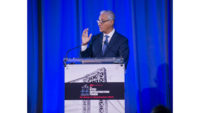Sustainability
Manhattan's Landmark US Custom House Getting Greener-Material Repairs
Federal building using $11 million from Inflation Reduction Act

Beaux Arts-style landmark will get a new subgrade "bathtub" structure and associated sidewalk and street repairs using lower-carbon concrete, steel and asphalt, says GSA.
Photo by Nadine M. Post/ENR
Consigli Construction, the general contractor for the sustainable-materials upgrade of the below-grade “bathtub” surrounding the 501,000-sq-ft Alexander Hamilton U.S. Custom House in Lower Manhattan, is likely to mobilize the $68-million project next month, according to the U.S. General Services Administration, the owner of the national historic landmark. GSA Administrator Robin Carnahan announced Aug. 15, as she toured the building, that the 39-month project will use $11 million in funding from the 2022 Inflation Reduction Act.
For the bathtub and associated sidewalk and street repairs, GSA will prioritize the procurement of American-made, substantially lower-embodied-carbon concrete, steel and asphalt. The goal, says GSA, is to avoid an aggregate of 39 metric tons of embodied carbon in the manufacturing supply chain for the reinforced-concrete bathtub, while promoting cleaner American manufacturing.
The Custom House work is in support of President Joe Biden’s Federal Buy Clean Initiative, intended to catalyze investment in clean construction materials. “We are excited to use this project as a showcase,” said Carnahan.
 GSA Administrator Carnahan (right) selected the Customs House as a showcase for sustainable materials because the project was ready to go.
GSA Administrator Carnahan (right) selected the Customs House as a showcase for sustainable materials because the project was ready to go.Photo by Nadine M. Post/ENR
The new bathtub, which consists of a 16-ft-tall reinforced concrete wall under the sidewalk outside the 320-ft x 300-ft building, is the first phase of an estimated $131.3-million project, designed by SuperStructures Engineers + Architects, to modernize and enhance the sustainability of the building; preserve the historic architecture and art; repair damage from water infiltration; and implement other structural repairs.
The construction manager for the two-phase project is Turner Townsend Heery, but the timeline for the second phase has not yet been established and the contractor not yet selected, according to Elizabeth Wanga, GSA’s project manager.
The Custom House contains the U.S. Bankruptcy Court for the Southern District of New York, the Smithsonian Institution’s National Museum of the American Indian, the New York City office of the National Archives and Records Administration and other federal offices.
Sustainable Materials Showcase
GSA selected the seven-story landmark as a sustainable materials showcase because the retrofit, in the works for several years but stalled due to funding delays, was ready to move forward, said Carnahan. The need had been there since Superstorm Sandy flooded the basement in 2012, she added.
The Beaux Arts-style building was designed by the architect Cass Gilbert and includes artwork by Daniel Chester French and Reginald Marsh. Square in plan, with a central rotunda, the steel-framed structure has a heavily detailed gray granite facade with monumental sculptures in the front. Built between 1901 and 1907, the building was listed in the National Register of Historic Places in 1972 and was designated a National Historic Landmark in 1976.
The last major renovation was completed in 1994 at a cost of $42 million, when the 82,000-sq-ft National Museum of the American Indian opened. From 1973 to 1984, the building lay vacant and neglected by the GSA. In 1984, the Federal Bankruptcy Courts moved into two upper floors.
The Custom House ''is one of the best Beaux Arts buildings in the country,'' said Nancy T. McCoy, project architect for Ehrenkrantz & Eckstut Architects, at the time of the renovation.
Net Zero Emissions Goal
GSA is driving toward the Biden administration’s goal to achieve net-zero operational emissions for the federal buildings portfolio by 2045. Overall, projects supported by the IRA include $3.4 billion to GSA for low-embodied carbon materials, emerging and sustainable technologies and other measures to improve the sustainability of the federal footprint, says GSA.
The retrofits create jobs, “cut energy consumption and save the taxpayers money,” said Carnahan.
GSA estimates that the $3.4 billion in investments will create, each year, over 9,500 jobs nationwide for the duration of the projects; support $2.8 billion in labor income; and generate nearly $1 billion in tax revenue for federal, state and local governments. In total, IRA investments from GSA are expected to avoid more than 2.3 million metric tons of emissions and result in lower utility costs of about $474 million over the next two decades.






